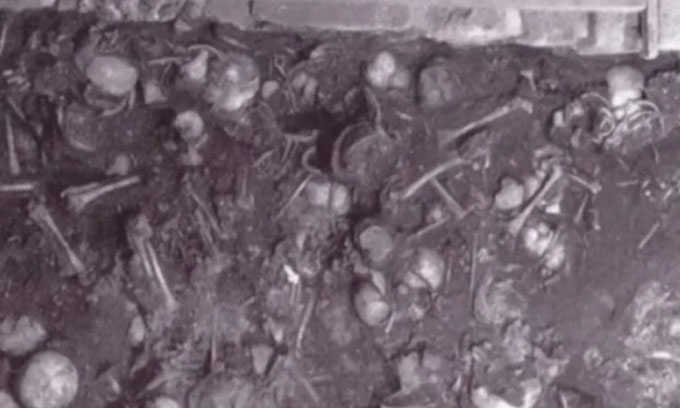Decoding the Aztec child sacrifice during drought
At least 42 children were sacrificed in Tenochtitlán to appease the rain god's anger during a prolonged drought.
Mass child sacrifices to the rain god in 15th-century Mexico coincided with a severe drought in the region, according to research presented at the "Water and Life" conference at the National Autonomous University of Mexico, Live Science reported on Nov. 15. The remains of at least 42 children between the ages of 2 and 7 were discovered in the Templo Mayor , the most important temple complex in Tenochtitlán, now Mexico City, in 1980 and 1981. The skeletons were lying on their backs with their limbs bent, placed inside stone boxes on a sandy floor. Some wore jewelry such as necklaces and held bluestone beads in their mouths.

Remains at the Templo Mayor temple complex. (Photo: INAH).
New research reveals that the sacrifice was likely an attempt to end a severe drought in the region by offering sacrifices to the rain god Tláloc .
"Initially, the city-state sought to mitigate the effects of the drought by opening the royal granaries to distribute food to those in need, and by carrying out mass child sacrifices at the Templo Mayor to appease the wrath of the tlaloques, the dwarves who were considered assistants to the god Tláloc ," said archaeologist Leonardo López Luján, director of the Templo Mayor Project at the National Institute of Anthropology and History (INAH). "For a while, they coped with the tragedy in this way, but the prolonged crisis forced the city-state to emigrate en masse."
To find out why the mass sacrifices took place, the INAH team studied geological data along with information from the Mexican Drought Atlas network. They discovered that a major drought occurred in central Mexico between 1452 and 1454. The drought, which occurred during the reign of Moctezuma I and the construction of the Templo Mayor, caused crop failures, devastated the settlement, and forced starving families to sell their children to neighboring towns in exchange for food.
"All the data indicate that early summer drought affected the germination, growth and flowering of plants before the summer solstice, while autumn frosts hit the maize crop before harvest. Both phenomena destroyed crops and led to prolonged famine ," said López Luján.
In an effort to alleviate the crisis, the bodies of the sacrificed children were sprinkled with blue dye, seashells, and small birds, and surrounded by 11 statues made from volcanic rock. The statues resembled the faces of Tláloc, the Aztec god of rain, water, and fertility.
- Revealing little things to know about the Aztec gods
- Mexico found the body of the child who used the spirit in ancient Aztec temple
- The secret of the Aztec empire: Because of an eagle that drained the swamp, then the 'treasure' of a hundred years was revealed!
- Discovered 500-year-old wolf dog covered with pure gold
- The mystery of the ancient Aztec warrior's cotton armor, against both the sword or the javelin
- 500-year-old gold ingot of Aztec empire
- Bacteria know how to cooperate and sacrifice for their kind
- Australia is at risk of facing a decades-long super drought
- Mask mysterious skulls in ancient Aztec temples
- New explanation for the mass sacrifice of children
- Sacrifice strange people in Syria
- Discovered 500-year-old remains of the Aztec empire
 Discovered an ancient centipede fossil 99 million years old
Discovered an ancient centipede fossil 99 million years old Discovered bat-like dinosaurs in China
Discovered bat-like dinosaurs in China Discovered a 200-year-old bronze cannon of the coast
Discovered a 200-year-old bronze cannon of the coast Discover 305 million-year-old spider fossils
Discover 305 million-year-old spider fossils